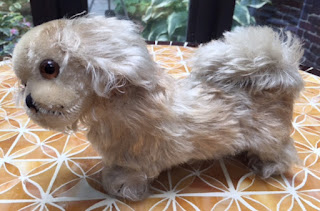After a two year pause due to COVID-19 public health concerns, Ladenburger Spielzeugauktion's Special Steiff Auction will again take place in Giegnen as part of Margarete Steiff GmbH's annual three day Sommer event. This signature festival happens on June 24th-26th 2022, and Ladenburger's auction takes place the evening of June 25th in the town's historic Schranne hall. This sale always features the best of the best - and this year is no different. Here are three rare and interesting temptations from the auction that really caught Steiffgal's eye.

"Pin-cushion, lion, around 1905, velvet lion with mohair mane, very nice clearly visible colors, great condition, small STEIFF button with block letters, long trailing F, on a green mohair pin-cushion, minimally faults at the mohair of the pin-cushion, otherwise very nice condition, length of the cushion: 16 x 11 cm, height with lion: 14 cm, exceptional, very nice condition."
Steiff has a long tradition of creating novelties like pincushions from some of their most popular designs of the time. This particular lion pattern appeared in the catalog in 10 and 14 cm from 1904-1919 overall. The lion itself - sans cushion - was produced in 10 and 14 cm from 1903-1912 overall. Other prewar pincushion designs included animals wearing backpack style pincushions made from baskets and velvet, pets perched on fluffy mohair pillows, and woolen miniatures posed on thick felt leaves. This particular example is in wonderful condition with ID. The lion's royal personality just radiates from within, don't you think?
The next pick is truly a looker. It is lot #6071, a mid-century manufacturing display. It has an opening bid of €130 and is cataloged simply as...
"Show piece, board made of cardboard, development of a Steiff-lion 5312, 43 cm and 30 cm, around 1954."
This dashing display shows the steps needed to create the company's "Mama Lioness." This early prewar design was produced in 12 and 21 cm from 1949 through 1957 and is considered relatively rare and desirable on the secondary market. So the date on the display of 1954 makes perfect sense.
The words on the sign basically summarize how the lioness comes together. They roughly translate to: "History of a Steiff Lion 5312. Work steps: cut, sew, turn around, sew limbs on, ears, garnish the nose, shape, paint, check, protect." The poster also includes examples of the raw materials used at each step of the process, and a finished Lioness. It is interesting to imagine what this display was created for.... training, public relations, part of a museum or traveling exhibit? Today, it is just a fabulous time capsule and a great piece of visual as well as teaching art.

"Billy-Goat (billy goat), advertising item by the company Scabal, 1959, wool plush, with monocle and caricature eyes, standing height with hat 40 cm, complete, No. 6535,90, very good condition, hat is a bit creased."
What a fun item! Goat's playful, blue and black glass eyes are meant to be silly and cartoon-like, and are almost identical to those seen on the Steiff's beloved Lulac rabbits of the same period. His "proper topper" and black vest add a touch of formality to him. And his numbering describes him accurately, with 6 = young, 5 = wool plush, 35 = his height, almost; 9 = display animal or special edition, and 0 = natural coloring.
But what's the tie between goats and the company Scabal? According to Wikipedia, Scabal is... "a Belgian textile company founded in 1938 by Otto Hertz as a cloth merchant and supplier of fabrics. "Scabal" is an acronym for Société Commerciale Anglo Belgo Allemande Luxembourgeoise." Goats are famous for producing mohair and cashmere, and Scabal may use these fine fibers in their cloth production. It is also possible that this goat design somehow was part of the company's branding or identity in the late 1950s. So the dandy goat design really does tie back to the business of Scabal.
Steiffgal hopes this discussion on these fabulous Steiff auction treasures has further buttoned up your love of the brand.
For more information about Ladenburger Spielzeugauktion GmbH's upcoming Special Steiff Auction event on June 25th, please click here!
Have a question about one of your Steiff treasures? Let's talk! Click here to learn more!




















